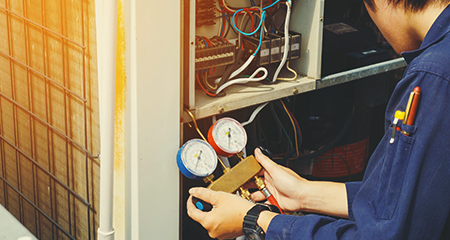If your furnace is not working, you could end up facing a variety of problems. Not only is your home uncomfortable, but depending on the weather, it can also put your home at risk for bursting water pipes, mold and a host of other problems. If you're having furnace problems, you may be concerned about the expense of hiring a professional to perform repairs. Before you call on the pros, you may want to try the following tips to troubleshoot issues with your furnace.
What to check if your furnace won't work
While modern gas furnaces are more efficient than those from years ago, they can be more complicated to operate. In the past, furnace problems may have been caused by a troublesome pilot light from a dirty thermocouple. With advances to thermostats in recent years, today’s furnace problems may involve air inducers, electronic ignition sensors, pressure switches and exhaust flow monitoring.
Even so, there are a few basic things you can quickly check over if your furnace is not working.
Having issues when you start up your furnace?
If you experience issues when you start up your furnace this year, make sure your furnace is getting power. Check your fuse box for any tripped circuit breakers, especially since this could indicate a bigger problem with your electrical system. Next, ensure that the furnace power has been switched to "on." If your furnace is located in a confined space, you may have accidentally switched your furnace to "off".
Look for the power switch mounted on the side of the furnace. It may also include a liftable metal housing containing a fuse. If the fuse is blackened and burnt, then it will need to be replaced. However, remember that a blown fuse may also indicate a bigger electrical system problem, so the system should be inspected by a technician.
Still having furnace problems after starting up?
If you've already fired up your furnace this heating season, look outside to make sure nothing is blocking the fresh air intake and the exhaust, as not all furnaces vent through chimneys. Many newer furnaces' fresh air intakes and exhausts run through the side of the home, and sometimes windblown leaves, insects, and moisture issues can harm heating systems. If this is the case, you might want to consult a licensed technician about possible venting solutions.
Potential furnace problems
Thermostat
The thermostat is a common reason why your furnace may not be working, so you should check your thermostat settings. Make sure you’ve set your thermostat to "heat" at temperature high enough for the furnace to come on. While that sounds obvious, it's a small detail that is easy to forget. Ironically, programmable thermostat settings that are meant to be helpful can be confusing to the user.
Some programmable thermostats (PTs) can be quite complicated and difficult for users to understand, leading to errors in operation and wasted energy. For that reason, it's a good idea to store your thermostat's user guide near the thermostat. That way, you can consult its troubleshooting section if a problem arises.
If your furnace is not working, it’s important that you check the thermostat’s batteries. Many programmable thermostats feature a flashing "low battery" icon on their control screen. If you see a "low battery" warning, promptly replace them with new batteries. If you see other potential problems near your battery housing, such as burn marks or other residues, contact a professional to inspect it.
Air filter
If your furnace is not working, your next step should be to check the air filter. As a general rule, you should replace the air filters in your heating system every 3 months. The air filter is an important feature on your furnace because it traps dust and other particles that can damage the furnace’s motor. As it is the case with any air filters on other machines like cars and dryers, the air filter gets dirty over time and you need to replace it.
If all else fails...
If you've gone through these steps and your furnace is still not working, then it may be time to call a professional technician. Newer gas furnaces are far more complex than earlier models, so you need expert advice. Trying to do repairs on your own when your furnace is not working can lead to costly mistakes.
A service technician can tell you about factors that are common to your furnace make and model that you may be able to resolve yourself in the future. They can also identify and repair components before they require an expensive emergency service call.
The best way to keep your furnace efficient and reliable is to have a professional inspect it before you really need it. Before cold weather strikes, set up an appointment to have an expert inspect your heating system. Yearly fall maintenance can save you time, frustration, and money when it's done right.


















